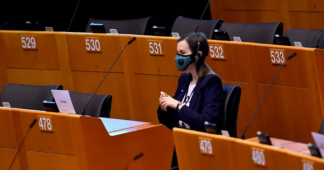The European Commission’s original allocation mechanism really favoured lower-income countries and to a large extent was based on pre-COVID economic data. The modification adopted by the European Council gives more consideration to the country size and the adverse economic impact of COVID-19. As a consequence, by using the Commission’s May 2020 economic forecasts, I estimate that only Germany and France will get more grants from the EU’s recovery fund compared to the Commission’s original proposal, while other countries will get less.
By Zsolt Darvas
July 23, 2020
The grand EU budget deal reached by the European Council on 21 July 2020, which includes a one-time €750 billion recovery fund named ‘Next Generation EU’ (NGEU), is unprecedented. For the first time in its history, the EU will borrow from capital markets to finance expenditures throughout the Union.
The NGEU deal includes some notable modifications compared to the Commission’s original proposal. It reduces the overall amounts of grants and guarantees and increases the amount of loans. It abolishes certain instruments, including all proposed funding for non-EU countries. And it alters the cross-country allocation method of the largest instrument, the Recovery and Resilience Facility (RRF).
In Table 1 I compare the overall amounts available for the various recovery instruments with the original proposal of the Commission.
In this post, I focus on the changes in the allocation key for the recovery instruments that was decided (see the methodology here). Overall, the allocation key has shifted from favouring low-income countries towards better considering the country size and favouring those countries that were hit by a stronger decline in GDP. It thus became closer to an insurance system.
The most important change relates to the cross-country allocation of the RRF. 70% of the grants provided by the RRF shall be committed in the years 2021 and 2022, according to the Commission’s original proposal. The remaining 30% shall be committed in 2023, for which “the 2015-2019 unemployment criterion is replaced, in equal proportion, by the loss in real GDP observed over 2020 and by the cumulative loss in real GDP observed over the period 2020-2021” (see points A15 and A16 here).
To understand the importance of this change, let me briefly recall the Commission’s original cross-country allocation proposal for the RRF (see further details in my previous post, particularly in the annex). That allocation depends on (a) the 2019 population, (b) the inverse of 2019 GDP per capita, and (c) the 2015-2019 average unemployment rate, all relative to the EU27 value. Relative GDP per capita is measured in current euro values (not in purchasing power parity) and the inverse of its ratio to the EU average is capped at 1.5. The unemployment rate ratio is capped at 1.5 for countries with GDP per capita below the EU average and at 0.75 for countries with GDP per capita above the EU average.
Therefore, only one out of the three indicators (population) depends on the size of the country, the other two indicators (GDP per capita and unemployment rate) are independent from the country size. The three ratios are multiplied with each other. That means that the population ratio sets the country’s population share in EU population; that share is then multiplied by ratios around 1, whereby eg, an unemployment rate ratio (the ratio of the country’s unemployment rate to the EU’s unemployment rate) higher than 1 increases the country’s overall share in the RRF allocation, while an unemployment rate ratio below 1 decreases it. Yet the 0.75 cap on the unemployment rate ratio for higher-income countries, as well as the use of the inverse GDP/capita ratio (which is further enlarged by using current euro values and not purchasing power parity values) further favour lower-income countries.
In short, the Commission’s original allocation mechanism really favours lower-income countries. Such a favouring is also very significant in the allocation of the ReactEU funds. This favouring is the main reason why eg, Bulgaria, Croatia and Greece were expected to obtain grants and guarantees amounting to about 15% of their GDP from the recovery tools (see my calculations on Figure 1 here, and Table A1 on page 51 of Commission Staff Working Document here).
The proposed RRF allocation mechanism is confirmed by the European Council for 70% of RRF grants. However, for the remaining 30%, the unemployment ratio indicator applied is replaced by the loss in real GDP. In its conclusions, the European Council does not specify how to measure “the loss in real GDP”, but this expression has been used by the Commission for the allocation mechanism of ReactEU; it is meant to describe the fall in the constant-price euro value of GDP, which is in line with the meaning of “the loss in real GDP”.
However, the fall of GDP valued in constant-price euro depends on the country size. The larger the country, the larger the euro value of the GDP fall. Hence, an indicator that is independent of the country’s size (unemployment rate) is replaced by an indicator that very much depends on the country’s size (loss in real GDP). In its conclusions, the European Council does not indicate any additional criteria for consideration of real GDP loss regarding the RRF. In contrast, ReactEU has a complicated cap system for a similar GDP loss indicator . The ReactEU capping was explicitly confirmed by the European Council (see point A20 of the conclusions).
This change in the RRF allocation mechanism mitigates the favouring of lower-income countries in the Commission’s proposal, and benefits larger countries and those that suffered larger losses in GDP due to the pandemic.
Beyond the country size issue, Germany further benefits from the changed allocation criterion, because it had a very low unemployment rate in 2015-2019. France also benefits beyond the country size issue, because even though it had a higher unemployment rate than the EU average in 2015-2019, its unemployment rate indicator was subject to the 0.75 cap applied for higher income countries.
The allocation criteria of instruments other than the RFF has not been changed by the European Council, except a small change for ReactEU: Luxembourg will get an extra lump sum €100 million and Malta an extra €50 million.
For estimating the impact of the change in allocation criteria, I use the May 2020 Commission economic forecasts. I find that only three countries, Germany (by €20.4 billion), France (by €12.4 billion) and Italy (by €5 billion) will get more grants from RFF, all other countries will get less. And since grants in other recovery instruments were cut substantially for all countries, only Germany (by €13.4 billion) and France (by €7.4 billion) will get more grants from the overall recovery package compared to the Commission’s original proposal (see Table 2). Overall, Italy will get €1 billion less in grants, Spain will get €9.5 billion less, while Poland will get €11.4 billion less.
The overall envelope for guarantees available for EU countries in the recovery instruments was drastically cut from €61.6 billion to €5.6billion. In that way, all EU countries will be entitled to less than 10% of the guarantees initially proposed by the Commission (Table 3).
The grand EU budget deal reached by the European Council on 21 July 2020, which includes a one-time €750 billion recovery fund named ‘Next Generation EU’ (NGEU), is unprecedented. For the first time in its history, the EU will borrow from capital markets to finance expenditures throughout the Union.
The NGEU deal includes some notable modifications compared to the Commission’s original proposal. It reduces the overall amounts of grants and guarantees and increases the amount of loans. It abolishes certain instruments, including all proposed funding for non-EU countries. And it alters the cross-country allocation method of the largest instrument, the Recovery and Resilience Facility (RRF).
In Table 1 I compare the overall amounts available for the various recovery instruments with the original proposal of the Commission.
In this post, I focus on the changes in the allocation key for the recovery instruments that was decided (see the methodology here). Overall, the allocation key has shifted from favouring low-income countries towards better considering the country size and favouring those countries that were hit by a stronger decline in GDP. It thus became closer to an insurance system.
The most important change relates to the cross-country allocation of the RRF. 70% of the grants provided by the RRF shall be committed in the years 2021 and 2022, according to the Commission’s original proposal. The remaining 30% shall be committed in 2023, for which “the 2015-2019 unemployment criterion is replaced, in equal proportion, by the loss in real GDP observed over 2020 and by the cumulative loss in real GDP observed over the period 2020-2021” (see points A15 and A16 here).
To understand the importance of this change, let me briefly recall the Commission’s original cross-country allocation proposal for the RRF (see further details in my previous post, particularly in the annex). That allocation depends on (a) the 2019 population, (b) the inverse of 2019 GDP per capita, and (c) the 2015-2019 average unemployment rate, all relative to the EU27 value. Relative GDP per capita is measured in current euro values (not in purchasing power parity) and the inverse of its ratio to the EU average is capped at 1.5. The unemployment rate ratio is capped at 1.5 for countries with GDP per capita below the EU average and at 0.75 for countries with GDP per capita above the EU average.
Therefore, only one out of the three indicators (population) depends on the size of the country, the other two indicators (GDP per capita and unemployment rate) are independent from the country size. The three ratios are multiplied with each other. That means that the population ratio sets the country’s population share in EU population; that share is then multiplied by ratios around 1, whereby eg, an unemployment rate ratio (the ratio of the country’s unemployment rate to the EU’s unemployment rate) higher than 1 increases the country’s overall share in the RRF allocation, while an unemployment rate ratio below 1 decreases it. Yet the 0.75 cap on the unemployment rate ratio for higher-income countries, as well as the use of the inverse GDP/capita ratio (which is further enlarged by using current euro values and not purchasing power parity values) further favour lower-income countries.
In short, the Commission’s original allocation mechanism really favours lower-income countries. Such a favouring is also very significant in the allocation of the ReactEU funds. This favouring is the main reason why eg, Bulgaria, Croatia and Greece were expected to obtain grants and guarantees amounting to about 15% of their GDP from the recovery tools (see my calculations on Figure 1 here, and Table A1 on page 51 of Commission Staff Working Document here).
The proposed RRF allocation mechanism is confirmed by the European Council for 70% of RRF grants. However, for the remaining 30%, the unemployment ratio indicator applied is replaced by the loss in real GDP. In its conclusions, the European Council does not specify how to measure “the loss in real GDP”, but this expression has been used by the Commission for the allocation mechanism of ReactEU; it is meant to describe the fall in the constant-price euro value of GDP, which is in line with the meaning of “the loss in real GDP”.
However, the fall of GDP valued in constant-price euro depends on the country size. The larger the country, the larger the euro value of the GDP fall. Hence, an indicator that is independent of the country’s size (unemployment rate) is replaced by an indicator that very much depends on the country’s size (loss in real GDP). In its conclusions, the European Council does not indicate any additional criteria for consideration of real GDP loss regarding the RRF. In contrast, ReactEU has a complicated cap system for a similar GDP loss indicator . The ReactEU capping was explicitly confirmed by the European Council (see point A20 of the conclusions).
This change in the RRF allocation mechanism mitigates the favouring of lower-income countries in the Commission’s proposal, and benefits larger countries and those that suffered larger losses in GDP due to the pandemic.
Beyond the country size issue, Germany further benefits from the changed allocation criterion, because it had a very low unemployment rate in 2015-2019. France also benefits beyond the country size issue, because even though it had a higher unemployment rate than the EU average in 2015-2019, its unemployment rate indicator was subject to the 0.75 cap applied for higher income countries.
The allocation criteria of instruments other than the RFF has not been changed by the European Council, except a small change for ReactEU: Luxembourg will get an extra lump sum €100 million and Malta an extra €50 million.
For estimating the impact of the change in allocation criteria, I use the May 2020 Commission economic forecasts. I find that only three countries, Germany (by €20.4 billion), France (by €12.4 billion) and Italy (by €5 billion) will get more grants from RFF, all other countries will get less. And since grants in other recovery instruments were cut substantially for all countries, only Germany (by €13.4 billion) and France (by €7.4 billion) will get more grants from the overall recovery package compared to the Commission’s original proposal (see Table 2). Overall, Italy will get €1 billion less in grants, Spain will get €9.5 billion less, while Poland will get €11.4 billion less.
The overall envelope for guarantees available for EU countries in the recovery instruments was drastically cut from €61.6 billion to €5.6billion. In that way, all EU countries will be entitled to less than 10% of the guarantees initially proposed by the Commission (Table 3)











